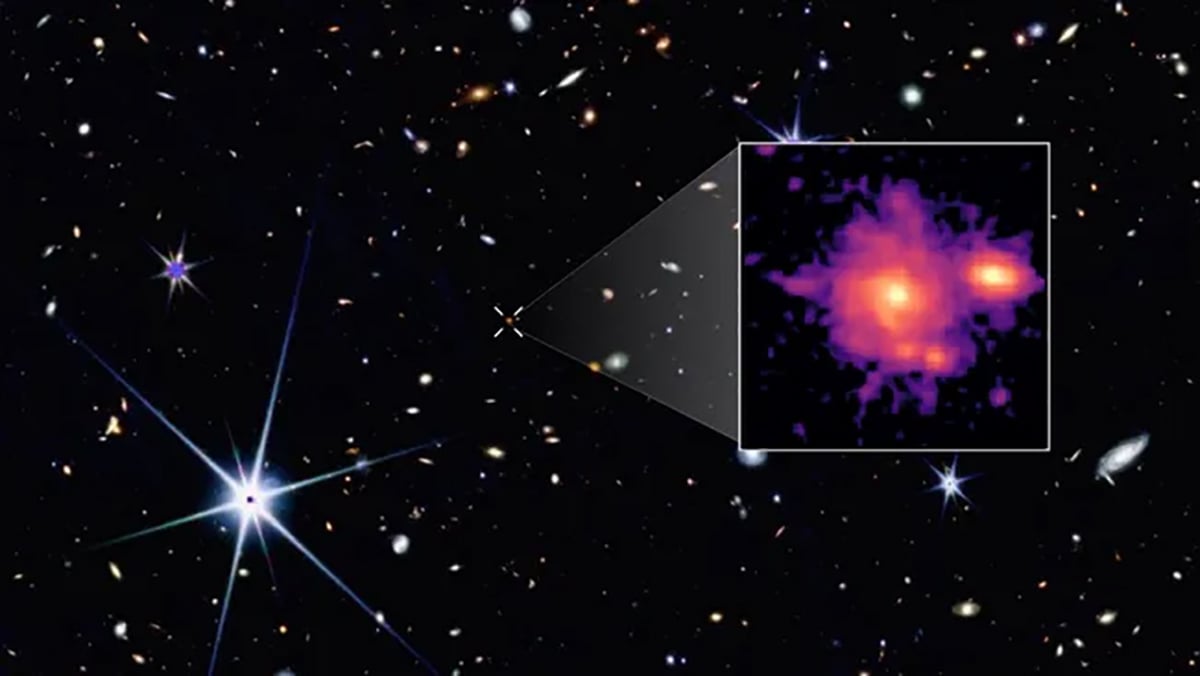
In a stunning breakthrough, NASA’s James Webb Space Telescope (JWST) has spotted a galaxy that defies expectations. Named Zhúlóng, this spiral galaxy looks strikingly like our Milky Way. But here’s the surprise, it existed just 1 billion years after the Big Bang. This discovery is forcing astronomers to rethink how early galaxies formed. Zhúlóng isn’t just any ancient galaxy. It’s a massive, organized spiral, something scientists didn’t expect to find so early in cosmic history.
What is Zhúlóng?
Zhúlóng is a distant spiral galaxy located at a redshift of z = 5.2. That means its light has traveled 12.8 billion years to reach us. We are seeing it as it looked when the universe was less than a tenth of its current age. What’s remarkable is how mature it appears. Zhúlóng has a central bulge, clear spiral arms, and a massive stellar disk. These features resemble the structure of modern galaxies like the Milky Way. The galaxy is about 62,000 light-years wide and has a stellar mass of around 100 billion solar masses. It also has a star formation rate of about 66 solar masses per year. These figures match or even exceed those of the Milky Way.

How was Zhúlóng discovered?
Zhúlóng was discovered during the PANORAMIC survey, an observational program using the James Webb Space Telescope. This survey focuses on early universe galaxies using infrared data from JWST’s NIRCam and MIRI instruments. These cameras can detect light from the most distant and ancient sources in the cosmos. When scientists analyzed the data, they found a massive galaxy with a clear spiral pattern. That galaxy turned out to be Zhúlóng. The telescope’s high-resolution imagery revealed fine details. The team was able to measure its rotation curve, study its dust content, and even estimate its star-forming activity.
What does the name “Zhúlóng” mean
Zhúlóng is named after a mythical dragon in Chinese mythology. The name translates to “Torch Dragon”, a creature said to control light and time. The name is fitting, this galaxy sheds light on an ancient period of the cosmos and challenges how we view time in galaxy formation. Naming it after a mythical timekeeper captures the spirit of discovery. This galaxy acts as a cosmic torch, illuminating the dark, early chapters of our universe.
Scientific implications
Astrophysicists are excited and surprised. Most didn’t think a galaxy this complex could form so early. This forces a revision of current galaxy formation models. Theorists must now account for rapid spiral structure formation. Some suggest that cold gas inflows and early dark matter halos might be responsible. Others propose that low merger rates allowed Zhúlóng to grow steadily.
Before this, scientists believed spiral galaxies took billions of years to evolve. The standard model suggested that early galaxies were chaotic, clumpy, and irregular. Spiral arms, bulges, and disks were features of a mature universe. Zhúlóng challenges that view. It proves that complex, structured galaxies could exist just 1 billion years after the Big Bang. This throws a wrench in current theories of galaxy formation.

Comparing Zhúlóng and the Milky Way
| Feature | Zhúlóng | Milky Way |
| Redshift | z = 5.2 | z = 0 (local) |
| Diameter | ~62,000 light-years | ~105,000 light-years |
| Stellar Mass | ~100 billion suns | ~100–200 billion suns |
| Star Formation Rate | ~66 solar masses/year | ~1–2 solar masses/year |
| Structure | Spiral arms, bulge | Spiral arms, bulge |
Zhúlóng isn’t just a faraway spiral, it’s a time machine. It gives us a glimpse into the dawn of galaxies. It proves that the universe was capable of more complexity, earlier than we thought. The James Webb Space Telescope has done what it was built for: revealing the unknown. Zhúlóng is a beacon from the ancient sky, lighting the way for the next chapter in astronomy.
Clear skies!

